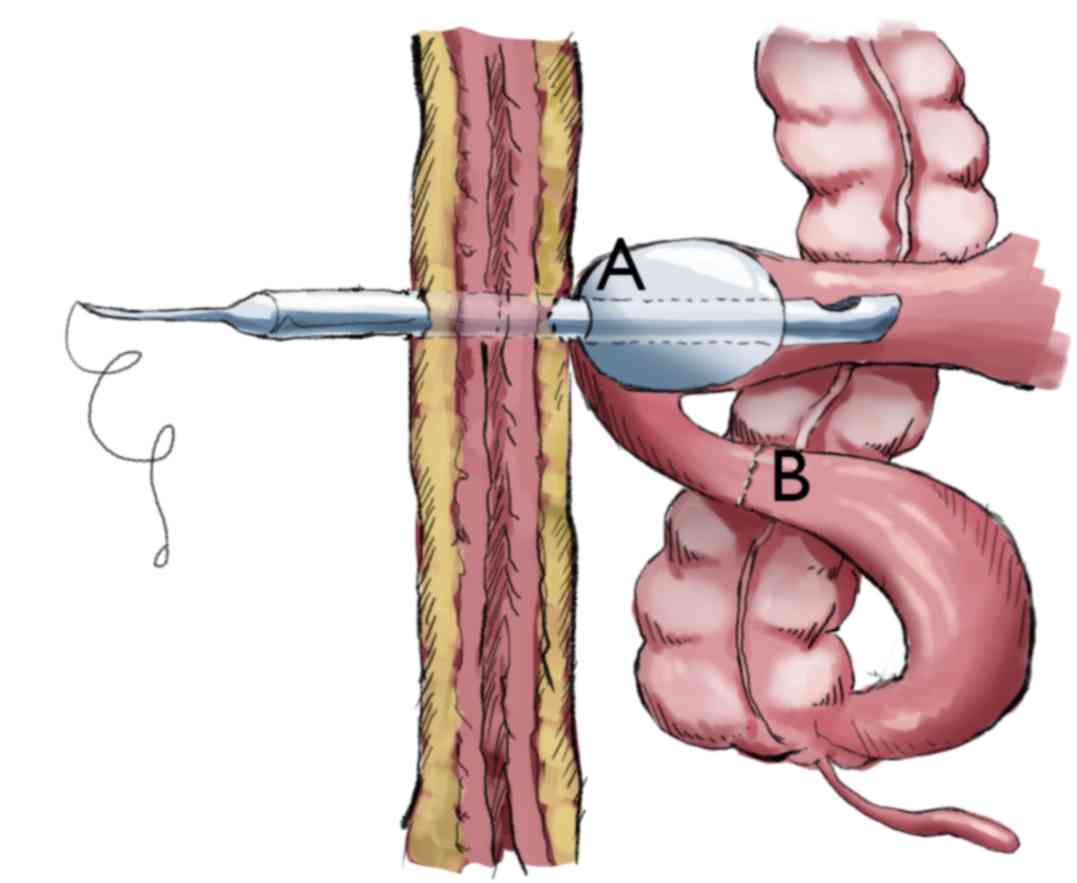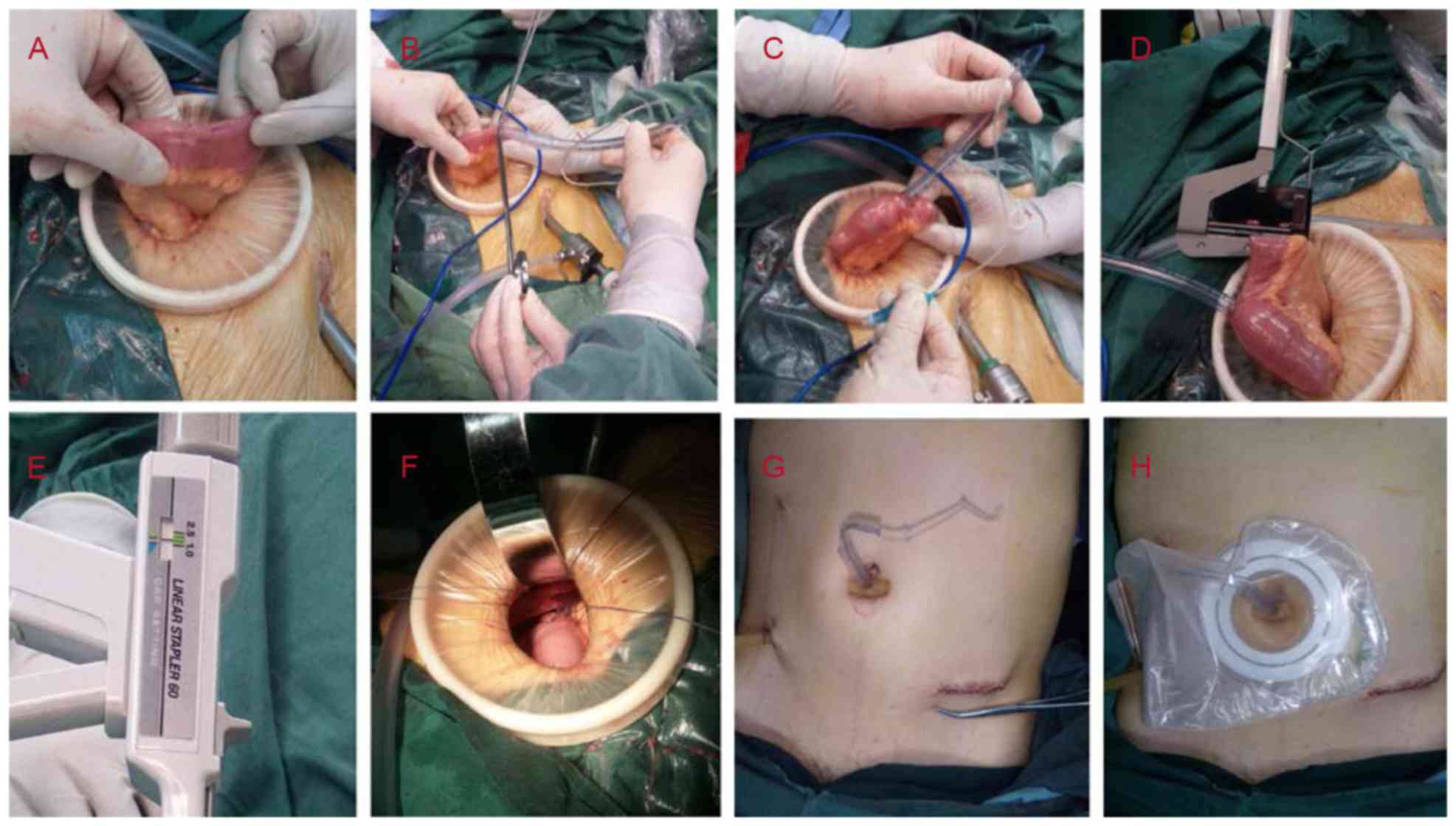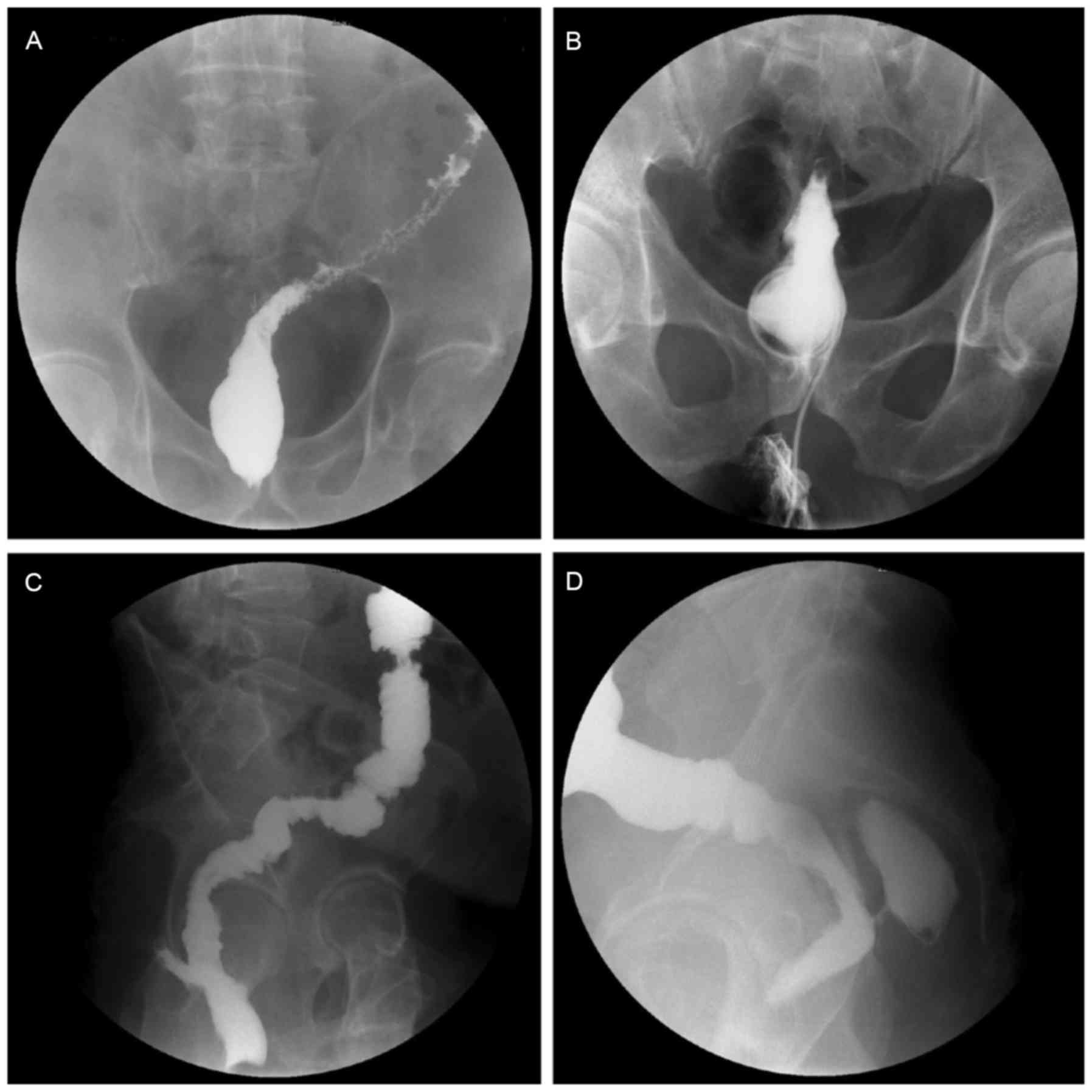|
1
|
Targarona EM, Balague C, Pernas JC,
Martinez C, Berindoague R, Gich I and Trias M: Can we predict
immediate outcome after laparoscopic rectal surgery? Multivariate
analysis of clinical, anatomic, and pathologic features after
3-dimensional reconstruction of the pelvic anatomy. Ann Surg.
247:642–649. 2008. View Article : Google Scholar : PubMed/NCBI
|
|
2
|
Branagan G and Finnis D: Wessex Colorectal
Cancer Audit Working Group: Prognosis after anastomotic leakage in
colorectal surgery. Dis Colon Rectum. 48:1021–1026. 2005.
View Article : Google Scholar : PubMed/NCBI
|
|
3
|
Matthiessen P, Hallböök O, Andersson M,
Rutegård J and Sjödahl R: Risk factors for anastomotic leakage
after anterior resection of the rectum. Colorectal Dis. 6:462–469.
2004. View Article : Google Scholar : PubMed/NCBI
|
|
4
|
Park JS, Choi GS, Kim SH, Kim HR, Kim NK,
Lee KY, Kang SB, Kim JY, Lee KY, Kim BC, et al: Multicenter
analysis of risk factors for anastomotic leakage after laparoscopic
rectal cancer excision: The Korean laparoscopic colorectal surgery
study group. Ann Surg. 257:665–671. 2013. View Article : Google Scholar : PubMed/NCBI
|
|
5
|
Yeh CY, Changchien CR, Wang JY, Chen JS,
Chen HH, Chiang JM and Tang R: Pelvic drainage and other risk
factors for leakage after elective anterior resection in rectal
cancer patients: A prospective study of 978 patients. Ann Surg.
241:9–13. 2005.PubMed/NCBI
|
|
6
|
Anthuber M, Fuerst A, Elser F, Berger R
and Jauch KW: Outcome of laparoscopic surgery for rectal cancer in
101 patients. Dis Colon Rectum. 46:1047–1053. 2003. View Article : Google Scholar : PubMed/NCBI
|
|
7
|
Feliciotti F, Guerrieri M, Paganini AM, De
Sanctis A, Campagnacci R, Perretta S, D'Ambrosio G and Lezoche E:
Long-term results of laparoscopic versus open resections for rectal
cancer for 124 unselected patients. Surg Endosc. 17:1530–1535.
2003. View Article : Google Scholar : PubMed/NCBI
|
|
8
|
Park JS, Choi GS, Jun SH, Hasegawa S and
Sakai Y: Laparoscopic versus open intersphincteric resection and
coloanal anastomosis for low rectal cancer: Intermediate-term
oncologic outcomes. Ann Surg. 254:941–946. 2011. View Article : Google Scholar : PubMed/NCBI
|
|
9
|
Zhou ZG, Hu M, Li Y, Lei WZ, Yu YY, Cheng
Z, Li L, Shu Y and Wang TC: Laparoscopic versus open total
mesorectal excision with anal sphincter preservation for low rectal
cancer. Surg Endosc. 18:1211–1215. 2004. View Article : Google Scholar : PubMed/NCBI
|
|
10
|
Akiyoshi T, Ueno M, Fukunaga Y, Nagayama
S, Fujimoto Y, Konishi T, Kuroyanagi H and Yamaguchi T: Incidence
of and risk factors for anastomotic leakage after laparoscopic
anterior resection with intracorporeal rectal transection and
double-stapling technique anastomosis for rectal cancer. Am J Surg.
202:259–264. 2011. View Article : Google Scholar : PubMed/NCBI
|
|
11
|
Wang YW, Huang LY, Song CL, Zhuo CH, Shi
DB, Cai GX, Xu Y, Cai SJ and Li XX: Laparoscopic vs open
abdominoperineal resection in the multimodality management of low
rectal cancers. World J Gastroenterol. 21:10174–10183. 2015.
View Article : Google Scholar : PubMed/NCBI
|
|
12
|
Liu Z, Kang L, Huang M, Luo Y, Wang L, Lan
P, Cui J and Wang J: Open surgery against laparoscopic surgery for
mid-rectal or low-rectal cancer of male patients: better
postoperative genital function of laparoscopic surgery. Surg
Laparosc Endosc Percutan Tech. 25:444–448. 2015. View Article : Google Scholar : PubMed/NCBI
|
|
13
|
Li S, Jiang F, Tu J and Zheng X: Long-term
oncologic outcomes of laparoscopic versus open surgery for middle
and lower rectal cancer. PLoS One. 10:e01358842015. View Article : Google Scholar : PubMed/NCBI
|
|
14
|
Vargas GM, Sieloff EP, Parmar AD, Tamirisa
NP, Mehta HB and Riall TS: Laparoscopy decreases complications for
obese patients undergoing elective rectal surgery. Surg Endosc.
30:1826–1832. 2016. View Article : Google Scholar : PubMed/NCBI
|
|
15
|
Bell SW, Walker KG, Rickard MJ, Sinclair
G, Dent OF, Chapuis PH and Bokey EL: Anastomotic leakage after
curative anterior resection results in a higher prevalence of local
recurrence. Br J Surg. 90:1261–1266. 2003. View Article : Google Scholar : PubMed/NCBI
|
|
16
|
Jung SH, Yu CS, Choi PW, Kim DD, Park IJ,
Kim HC and Kim JC: Risk factors and oncologic impact of anastomotic
leakage after rectal cancer surgery. Dis Colon Rectum. 51:902–908.
2008. View Article : Google Scholar : PubMed/NCBI
|
|
17
|
Matthiessen P, Hallbook O, Rutegard J,
Simert G and Sjödahl R: Defunctioning stoma reduces symptomatic
anastomotic leakage after low anterior resection of the rectum for
cancer: A randomized multicenter trial. Ann Surg. 246:207–214.
2007. View Article : Google Scholar : PubMed/NCBI
|
|
18
|
Huser N, Michalski CW, Erkan M, Schuster
T, Rosenberg R, Kleeff J and Friess H: Systematic review and
meta-analysis of the role of defunctioning stoma in low rectal
cancer surgery. Ann Surg. 248:52–60. 2008. View Article : Google Scholar : PubMed/NCBI
|
|
19
|
Shiomi A, Ito M, Saito N, Ohue M, Hirai T,
Kubo Y and Moriya Y: Diverting stoma in rectal cancer surgery. A
retrospective study of 329 patients from Japanese cancer centers.
Int J Colorectal Dis. 26:79–87. 2011. View Article : Google Scholar : PubMed/NCBI
|
|
20
|
Yoo SB, Jeong SY, Lim SB, Park JW, Choi HS
and Oh JH: Left-sided ileostomy at specimen extraction site in
laparoscopic-assisted low anterior resection for rectal cancer. J
Laparoendosc Adv Surg Tech A. 23:22–25. 2013. View Article : Google Scholar : PubMed/NCBI
|
|
21
|
Chang D, Zhang Y, Dang C, Zhu K, Li K,
Chen D and Chen W: Prevention of anastomotic leakage after low
anterior resection in rectal cancers. Hepatogastroenterology.
57:477–481. 2010.PubMed/NCBI
|
|
22
|
Ye F, Wang D, Xu X, Liu F and Lin J: Use
of intracolonic bypass secured by a biodegradable anastomotic ring
to protect the low rectal anastomosis. Dis Colon Rectum.
51:109–115. 2008. View Article : Google Scholar : PubMed/NCBI
|
|
23
|
Ye F, Chen D, Wang D, Lin J and Zheng S:
Use of Valtrac™-secured intracolonic bypass in laparoscopic rectal
cancer resection. Medicine (Baltimore). 93:e2242014. View Article : Google Scholar : PubMed/NCBI
|
|
24
|
Hua H, Xu J, Chen W, Zhou X, Wang J, Sheng
Q and Lin J: Defunctioning cannula ileostomy after lower anterior
resection of rectal cancer. Dis Colon Rectum. 57:1267–1274. 2014.
View Article : Google Scholar : PubMed/NCBI
|
|
25
|
Wang J, Ke B, Lin J, Xu J and Chen W:
Application of a spontaneously closed protective stoma in an ileal
pouch-anal anastomosis: A preliminary study. Int J Clin Exp Med.
8:1281–1285. 2015.PubMed/NCBI
|
|
26
|
Xu JZ, Wang J, Hua H, Lin C, Liu F, Li Y
and Chen W: Spontaneously closed protective stoma: A preliminary
report of exploratory study. Chin J Practical Surg. 32:1040–1042.
2012.
|
|
27
|
Edge SB and Compton CC: The American Joint
Committee on Cancer: The 7th edition of the AJCC cancer staging
manual and the future of TNM. Ann Surg Oncol. 17:1471–1474. 2010.
View Article : Google Scholar : PubMed/NCBI
|
|
28
|
Reyngold M, Niland J, ter Veer A, Milne D,
Bekaii-Saab T, Cohen SJ, Lai L, Schrag D, Skibber JM, Small W Jr,
et al: Neoadjuvant radiotherapy use in locally advanced rectal
cancer at NCCN member institutions. J Natl Compr Canc Netw.
12:235–243. 2014. View Article : Google Scholar : PubMed/NCBI
|
|
29
|
Peeters KC, Tollenaar RA, Marijnen CA,
Kranenbarg Klein E, Steup WH, Wiggers T, Rutten HJ and van de Velde
CJ: Dutch Colorectal Cancer Group: Risk factors for anastomotic
failure after total mesorectal excision of rectal cancer. Br J
Surg. 92:211–216. 2005. View
Article : Google Scholar : PubMed/NCBI
|
|
30
|
Rudinskaite G and Pavalkis D: Coloanal
anastomosis in rectal cancer surgery. Medicina (Kaunas).
38:624–630. 2002.PubMed/NCBI
|
|
31
|
Karanjia ND, Corder AP, Bearn P and Heald
RJ: Leakage from stapled low anastomosis after total mesorectal
excision for carcinoma of the rectum. Br J Surg. 81:1224–1226.
1994. View Article : Google Scholar : PubMed/NCBI
|
|
32
|
Dehni N, Schlegel RD, Cunningham C,
Guiguet M, Tiret E and Parc R: Influence of a defunctioning stoma
on leakage rates after low colorectal anastomosis and colonic J
pouch-anal anastomosis. Br J Surg. 85:1114–1117. 1998. View Article : Google Scholar : PubMed/NCBI
|
|
33
|
Ashburn JH, Stocchi L, Kiran RP, Dietz DW
and Remzi FH: Consequences of anastomotic leak after restorative
proctectomy for cancer: Effect on long-term function and quality of
life. Dis Colon Rectum. 56:275–280. 2013. View Article : Google Scholar : PubMed/NCBI
|
|
34
|
Law WL, Choi HK, Lee YM, Ho JW and Seto
CL: Anastomotic leakage is associated with poor long-term outcome
in patients after curative colorectal resection for malignancy. J
Gastrointest Surg. 11:8–15. 2007. View Article : Google Scholar : PubMed/NCBI
|
|
35
|
Laxamana A, Solomon MJ, Cohen Z, Feinberg
SM, Stern HS and McLeod RS: Long-term results of anterior resection
using the double-stapling technique. Dis Colon Rectum.
38:1246–1250. 1995. View Article : Google Scholar : PubMed/NCBI
|
|
36
|
Mirnezami A, Mirnezami R, Chandrakumaran
K, Sasapu K, Sagar P and Finan P: Increased local recurrence and
reduced survival from colorectal cancer following anastomotic leak:
Systematic review and meta-analysis. Ann Surg. 253:890–899. 2011.
View Article : Google Scholar : PubMed/NCBI
|
|
37
|
Rullier E, Laurent C, Garrelon JL, Michel
P, Saric J and Parneix M: Risk factors for anastomotic leakage
after resection of rectal cancer. Br J Surg. 85:355–358. 1998.
View Article : Google Scholar : PubMed/NCBI
|
|
38
|
Scott N, Jackson P, al-Jaberi T, Dixon MF,
Quirke P and Finan PJ: Total mesorectal excision and local
recurrence: A study of tumour spread in the mesorectum distal to
rectal cancer. Br J Surg. 82:1031–1033. 1995. View Article : Google Scholar : PubMed/NCBI
|
|
39
|
Buchs NC, Gervaz P, Secic M, Bucher P,
Mugnier-Konrad B and Morel P: Incidence, consequences and risk
factors for anastomotic dehiscence after colorectal surgery: A
prospective monocentric study. Int J Colorectal Dis. 23:265–270.
2008. View Article : Google Scholar : PubMed/NCBI
|
|
40
|
Buie WD, MacLean AR, Attard JA, Brasher PM
and Chan AK: Neoadjuvant chemoradiation increases the risk of
pelvic sepsis after radical excision of rectal cancer. Dis Colon
Rectum. 48:1868–1874. 2005. View Article : Google Scholar : PubMed/NCBI
|
|
41
|
Choi HK, Law WL and Ho JW: Leakage after
resection and intraperitoneal anastomosis for colorectal
malignancy: Analysis of risk factors. Dis Colon Rectum.
49:1719–1725. 2006. View Article : Google Scholar : PubMed/NCBI
|
|
42
|
Leichtle SW, Mouawad NJ, Welch KB, Lampman
RM and Cleary RK: Risk factors for anastomotic leakage after
colectomy. Dis Colon Rectum. 55:569–575. 2012. View Article : Google Scholar : PubMed/NCBI
|
|
43
|
Lipska MA, Bissett IP, Parry BR and Merrie
AE: Anastomotic leakage after lower gastrointestinal anastomosis:
Men are at a higher risk. ANZ J Surg. 76:579–585. 2006. View Article : Google Scholar : PubMed/NCBI
|
|
44
|
Martel G, Al-Suhaibani Y, Moloo H, Haggar
F, Friedlich M, Mamazza J, Poulin EC, Stern H and Boushey RP:
Neoadjuvant therapy and anastomotic leak after tumor-specific
mesorectal excision for rectal cancer. Dis Colon Rectum.
51:1195–1201. 2008. View Article : Google Scholar : PubMed/NCBI
|
|
45
|
Zaharie F, Mocan L, Tomuş C, Mocan T,
Zaharie R, Bartoş D, Bartoş A, Vlad L and Iancu C: Risk factors for
anastomotic leakage following colorectal resection for cancer.
Chirurgia (Bucur). 107:27–32. 2012.PubMed/NCBI
|
|
46
|
Smith JD, Paty PB, Guillem JG, Temple LK,
Weiser MR and Nash GM: Anastomotic leak is not associated with
oncologic outcome in patients undergoing low anterior resection for
rectal cancer. Ann Surg. 256:1034–1038. 2012. View Article : Google Scholar : PubMed/NCBI
|
|
47
|
Lin JK, Yueh TC, Chang SC, Lin CC, Lan YT,
Wang HS, Yang SH, Jiang JK, Chen WS and Lin TC: The influence of
fecal diversion and anastomotic leakage on survival after resection
of rectal cancer. J Gastrointest Surg. 15:2251–2261. 2011.
View Article : Google Scholar : PubMed/NCBI
|
|
48
|
Tai JD, Liu YS and Wang GY: Risk factors
and the management of anastomotic leakage after anus-preserving
operation for rectal cancer. Zhonghua Wei Chang Wai Ke Za Zhi.
10:153–156. 2007.(In Chinese). PubMed/NCBI
|
|
49
|
Network, . NCC: NCCN Clinical Practice
Guidelines in Oncology: Rectal cancer. Version I. Washington,
National Comprehensive Cancer Network. 2015.
|
|
50
|
Widder J, Herbst F, Dobrowsky W, Schmid R,
Pokrajac B, Jech B, Chiari C, Stift A, Maier A, Karner-Hanusch J,
et al: Preoperative short-term radiation therapy (25 Gy, 2.5 Gy
twice daily) for primary resectable rectal cancer (phase II). Br J
Cancer. 92:1209–1214. 2005. View Article : Google Scholar : PubMed/NCBI
|
|
51
|
Luna-Pérez P, Rodríguez-Ramírez S,
Rodriguez-Coria DF, Fernández A, Labastida S, Silva A and López MJ:
Preoperative chemoradiation therapy and anal sphincter preservation
with locally advanced rectal adenocarcinoma. World J Surg.
25:1006–1011. 2001. View Article : Google Scholar : PubMed/NCBI
|
|
52
|
Luna-Pérez P, Rodríguez-Ramírez S,
Hernández-Pacheco F, De La Barrera Gutiérrez M, Fernández R and
Labastida S: Anal sphincter preservation in locally advanced low
rectal adenocarcinoma after preoperative chemoradiation therapy and
coloanal anastomosis. J Surg Oncol. 82:3–9. 2003. View Article : Google Scholar : PubMed/NCBI
|
|
53
|
Chan A, Wong A, Langevin J and Khoo R:
Preoperative concurrent 5-fluorouracil infusion, mitomycin C and
pelvic radiation therapy in tethered and fixed rectal carcinoma.
Int J Radiat Oncol Biol Phys. 25:791–799. 1993. View Article : Google Scholar : PubMed/NCBI
|
|
54
|
Brigand C, Rohr S and Meyer C: Colorectal
stapled anastomosis: Results after anterior resection of the rectum
for cancer. Ann Chir. 129:427–432. 2004. View Article : Google Scholar : PubMed/NCBI
|












